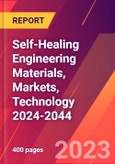Self-healing materials for engineering are exponentially growing in both research and sales. That makes old reports on the subject useless. To the rescue comes the new 400-page report, “Self-Healing Engineering Materials, Markets, Technology 2024-2044”. Over 70% of the self-healing market can be described as engineering, much of the rest being the very different requirements for healthcare - subject of a sister report. Projections show the total market having a CAGR of 21% to reach over $100 billion in 2044.
The engineering part can only be understood by a very close look at the latest research with continuous updates so you only get the latest in this rapidly-advancing field. From comparing the activities of 62 manufacturers, the huge research pipeline and our analysis, we come to many detailed conclusions and predictions. For example, polyurethanes, siloxanes and hydrogels will be most widely employed followed by epoxies, Diels-Alder compounds and fluoropolymers. Yes, these terms partly overlap but you get the picture. There is, literally, a supporting role for structures in self-healing material - the microcapsules, vascular systems and later scaffolds for Engineered Living Materials ELM. Your silicas and polyureas will be much in demand for these. Bottom line - many billion-dollar businesses will be created for your added-value materials.
The 48-page Executive summary and conclusions is sufficient for busy people. It has basics, 10 key conclusions, 9 SWOT analyses, 19 new infograms and pie charts, maturity curves for SH products 2024, 2034, 2044, detailed roadmap for 5 categories by year 2024-2044, forecasts by year 2024-2044 in 31 lines.
Chapter 2 introduces definitions, needs, the challenge of self-healing metrics and regulation and technology trends including biomimetics and beyond. That is 17 pages which are followed by the longest chapter at 87 pages covering the self-healing toolkit in the light of latest research and opinion including PhD level interpretation. Here is intrinsic vs extrinsic, autonomous or not then options - operational, physical, chemical, formulation, format. See the importance of nanomaterials, physical vs chemical approaches and self-healing when wet. Understand chemical families typically involved and the atomic toolkit for self-healing materials. See some of the important self-healing materials by application likely to be commercialised 2024-2044 with sections on a comparison table, hydrogels, polyurethanes, silicones, fluoropolymers. Mechanisms and promising research routes are explained with many examples. Here are recent breakthroughs in super-strong self-healing hydrogel for soft robotics, bioelectronics, cartilage, use of silica, Diels Alder materials, ionomers, supramolecular bonding and MSA, vitrimers and proteins such as polypeptides all in self-healing form with pros and cons. Learn why self-healing metals are proving so difficult
Next comes a careful explanation of latest extrinsic self-healing by microcapsules and vascular systems. What materials? Why? What next? The author surfaces geometrical design and challenges, fibers that strengthen and emit healant in engineering structures and vascular-like self-healing. The chapter ends with analysis of latest shape memory assisted self-healing SMASH technologies - capabilities, markets, technologies including hydrogel, polyolefin and polyurethane versions. Understand close-then-heal and fiber dispersion options and finally Engineered Living Materials ELM for growing a house or a load-bearing body part. There are many new infograms and SWOT analyses throughout.
Armed with that toolkit we then address the main engineering applicational sectors in the 41 pages of Chapter 4. With many latest research achievements presented, we here cover the closely related topics of aerospace, land and water transport, military and robotics then buildings and construction including making the new cooling layers self-healing, cementitious materials, asphalt, structural polymers and ceramics . Self-healing in energy: harvesting, storage and transmission comes next including the new self-healing perovskite photovoltaics and the new self-healing solid-state electrolytes in batteries and self-healing structural supercapacitors, for example. Lastly come information, computing and telecommunications ICT including massive areas of 6G reconfigurable intelligent surfaces and satcoms that need to be self-healing because, like so many other things covered, they will be massively expensive maintain and replace. Other needs end this chapter.
So what will you actually supply? That is answered by the next chapters with 42-page Chapter 5, “Self-healing adhesives, elastomers, coatings, e-skin, fibers: prospects 2024-2044”, 43-page Chapter 6, “Self-healing membranes and film: prospects 2024-2044” and 52 pages for Chapter 7, “Self-healing concrete, structural polymers, ceramics, asphalt: prospects 2024-2044”. The report then ends with the 23-page Chapter 8, “Self-healing companies compared”. It explains the value chain and the manufacturer percentages by application. Then comes a table comparing the activities in self-healing materials of 62 companies with eight columns for each including comments. Lastly, the self-healing activity of 12 of those companies are described and appraised in more detail.
The report is full of latest facts-based analysis, gaps in the market, quantified potential and detailed materials science. It is essential support for you to profitably participate in this very rapidly growing new business.
This report includes:
- Easily grasped new infograms, new comparison tables, new graphs, new roadmaps
- Many forecasts for self-healing materials and for the products likely to use them
- Clarifies the maze of different meanings for the term self-healing materials
- Primarily analyses rapid progress 2023 onwards forecasting 2024-2044
- Identifies which research chases non-existent or impossible problems
- Emphasis on your commercial opportunities and gaps in the market
- Terms explained in glossary and throughout text: business oriented
- Appraises the most promising research and best further reading
- Identifies which applications are likely to be large and when
- Identifies applications not yet addressed that could be large
- Profiles potential partners and most promising startups
- Identifies opportunities for your materials specialities
- Constantly updated so you only get the latest
- PhD level analysis and interviews
- 10 new SWOT appraisals
- Over 100 organisations
- 8 chapters 400 pages
Table of Contents
Methodology
Research Inputs Include:
- Appraisal of which targeted needs are genuine
- Web, literature, databases, experience and patents
- Close study of research pipeline
- Appraisal of regional initiatives
- Actitivies of standard bodies
- Limitations of physics and chemistry
- Interviews

LOADING...








